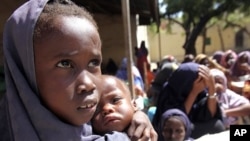As the drought continues in the Horn of Africa, the annual World Water Week (8/21-27) is about to begin. The event, sponsored by the Stockholm International Water Institute, examines the world’s major water issues.
No stranger to drought
“I don’t think the current crisis that we are experiencing in the Horn of Africa is directly related with drought, or at least drought is not the main cause of the problem,” said Dr. Ana Cascao, program manager at the institute, who’s been studying Africa’s water concerns.
Droughts have been occurring more frequently in the Horn of Africa. In January, weather experts warned of a severe drought. In 2007, the Intergovernmental Panel on Climate Change predicted severe problems in the Horn.
“This is a region that is a drought-prone region. If we want to talk specifically about Somalia, most of the country is dry lands or semi-arid area. So droughts are very frequent, almost every year. But, let’s say, every decade there is a big one,” she said.
Underlying problems & solutions
Cascao blames the crisis on structural problems and politics. She said people have been able to cope in past years, but not this year.
“We have to ask: why is that? So, one is, of course, in the case of Somalia itself, a lack of central state. So this idea that there is no central state that is able to provide aid or to find solutions for the problems, but also a lack of civil society. Another thing is also a lack of emergency measures,” she said.
Ethiopia, Kenya and parts of Uganda have also been hit by drought, but Cascao said, “They are able to cope because there had been already some responses or taking into account the early warning systems that had been alerting for the drought since November. These countries have been able to find solutions.”
Those solutions include bringing food from areas not affected by drought to areas that are and the effective use of international aid. “In Somalia, we are not experiencing that,” she said.
Cascao said Somaliland is probably having a worse drought than Somalia, but is better able to cope because it has a functioning government. Somalia has been without a strong government since the 1990s.
“Drought is not a new phenomenon in the region. The rainfall levels have been always low,” she said, adding, ”How do we respond to that in advance?”
She recommended social safety nets, microfinance of agriculture, livestock management and political solutions.
“Technical solutions are not enough,” she said, “One needs more than that…. One knows that the solution for Somalia is not going to be easy. So there is the need of the involvement of the region and the international community.”














